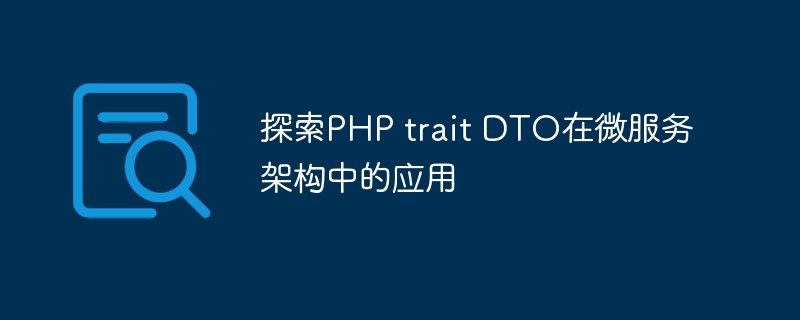

Explore the application of PHP trait DTO in microservice architecture
In today's software development industry, microservice architecture has become a trend and best practice . In this architecture, services are split into small, independent components, each responsible for completing a specific function. The benefits of this split include easier maintenance, expansion, and deployment, while also improving reusability. In a microservice architecture, a common problem is how to handle data interaction between services, and the PHP trait Data Transfer Object (DTO) is a good solution.
DTO is an object used to transmit data. They are usually simple pure data objects with no business logic. In a microservice architecture, different services need to exchange data frequently, and different programming languages and data formats may be used between services. By using DTO objects, we can transfer data between services while also converting between different programming languages and data formats.
In PHP, we can use traits to implement DTO. Trait is a code reuse mechanism in PHP that can achieve multiple inheritance. We can define a DTO trait, which contains the data fields and related methods we need. The following is an example:
trait UserDto
{
public $id;
public $name;
public $email;
public function __construct($id, $name, $email)
{
$this->id = $id;
$this->name = $name;
$this->email = $email;
}
public function toJson()
{
return json_encode([
'id' => $this->id,
'name' => $this->name,
'email' => $this->email,
]);
}
public static function fromJson($json)
{
$data = json_decode($json, true);
return new self(
$data['id'],
$data['name'],
$data['email']
);
}
}In the above example, we define a UserDto trait, which contains the three fields id, name and email, and also implements the toJson and fromJson methods to use DTO objects are serialized to JSON strings and deserialized from JSON strings to DTO objects.
In actual microservice applications, we can use the UserDto trait in different services. For example, it can be used in user services, order services, and mail services to transmit user data. When we need to send user data in one service to another service, we simply create a UserDto object and convert it to a JSON string using the toJson method and then send it to the target service. In the target service, we can use the fromJson method to deserialize the JSON string into a UserDto object and use the data in it.
One of the benefits of using traits to implement DTO is code reuse. We can use the same DTO trait in multiple services to avoid writing the same code repeatedly. Furthermore, by encapsulating the conversion logic in a DTO, we can more easily handle conversion between different data formats and programming languages.
In summary, the application of PHP trait DTO in the microservice architecture provides a simple and convenient solution for data interaction between services. By encapsulating data fields and conversion logic in DTOs, we can use the same code in different services and convert between data formats and programming languages easily. This approach helps us build a scalable, maintainable and reusable microservice architecture.
The above is the detailed content of Explore the application of PHP trait DTO in microservice architecture. For more information, please follow other related articles on the PHP Chinese website!